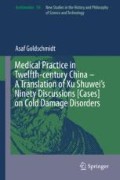Abstract
In this case Xu discusses one of the most important warning mentioned in the Treatise, namely that a physician should not apply draining downward treatment to a patient who has Cold Damage disorder as well as floating pulse. If one does drain such patient downward then a condition named Chest Bind will result and there is a real risk for the patient’s life. The case Xu presents follows this script to the letter except for the fact that once he intervenes he states that the patient is lucky and his pulse is not floating thus there is no risk for this life. In the discussion Xu quotes the relevant sentence from the Treatise and elaborates on how to apply it in the clinical scene.
Access this chapter
Tax calculation will be finalised at checkout
Purchases are for personal use only
Notes
- 1.
The same locality is mentioned in case #29.
- 2.
Chest Bind is a common and varied Cold Damage manifestation type. It results from heat pathogen invading the chest and binding with the body’s fluids. It is often due to misdiagnosis that leads to mistreatment. There are cold and hot, great and small, and water and blood types of Chest Bind. See Zhongyi da cidian, 2nd ed., p. 1363.
- 3.
See Scheid et al. 2009, pp. 793–795.
- 4.
- 5.
I accept Liu Jingzhao’s emendation (2006, p. 66): yang 陽 should read ge 隔 (diaphragm), visually similar. See Yu 1997, p. 56.
- 6.
I could not find the term “wuzheng 惡證” in any medical or other dictionary. Moreover, it does not fit the context very well.
Bibliography
Other Sources:
Mitchell, Craig, Feng Ye, and Nigel Wiseman. 1999. Shang Han Lun (On Cold Damage); Translation and Commentaries. Brookline, MA: Paradigm Publications.
Scheid, Volker, Dan Bensky, Andrew Ellis, and Randall Barolet. 2009. Chinese Herbal Medicine: Formulas and Strategies. Seattle: Eastland Press.
Yu, Bohai 于伯海, et. al. 1997. Shanghan jinkui wenbing mingzhu jicheng 伤寒金匮温病名著集成 [Collected Famous Works on Cold Damage, Golden Casket, and Febrile Disorders]. Beijing, Huaxia chubanshe.
Author information
Authors and Affiliations
Rights and permissions
Copyright information
© 2019 Springer Nature Switzerland AG
About this chapter
Cite this chapter
Goldschmidt, A. (2019). Case Number 38. In: Medical Practice in Twelfth-century China – A Translation of Xu Shuwei’s Ninety Discussions [Cases] on Cold Damage Disorders. Archimedes, vol 54. Springer, Cham. https://doi.org/10.1007/978-3-030-06103-6_39
Download citation
DOI: https://doi.org/10.1007/978-3-030-06103-6_39
Published:
Publisher Name: Springer, Cham
Print ISBN: 978-3-030-06102-9
Online ISBN: 978-3-030-06103-6
eBook Packages: MedicineMedicine (R0)

